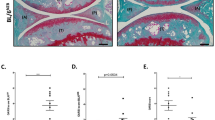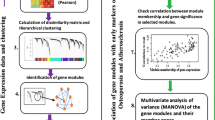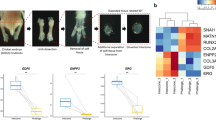Abstract
We report two brothers from a consanguineous couple with spondyloepimetaphyseal dysplasia (SEMD), multiple joint dislocations at birth, severe joint laxity, scoliosis, gracile metacarpals and metatarsals, delayed bone age and poorly ossified carpal and tarsal bones, probably representing a yet uncharacterized SEMD with laxity and dislocations. This condition has clinical overlap with autosomal dominantly inherited SEMD with joint laxity, leptodactylic type caused by recurrent missense variants in the kinesin family member 22 gene (KIF22). Single-nucleotide polymorphism array analysis and whole-exome sequencing in the two affected siblings revealed a shared homozygous nonsense variant [c.906T>A/p.(Tyr302*)] in EXOC6B as the most likely cause. EXOC6B encodes a component of the exocyst complex required for tethering secretory vesicles to the plasma membrane. As transport of vesicles from the golgi apparatus to the plasma membrane occurs through kinesin motor proteins along microtubule tracks, the function of EXOC6B is linked to KIF22 suggesting a common pathogenic mechanism in skeletal dysplasias with joint laxity and dislocations.
Similar content being viewed by others
Log in or create a free account to read this content
Gain free access to this article, as well as selected content from this journal and more on nature.com
or
References
Bonafe L, Cormier-Daire V, Hall C et al: Nosology and classification of genetic skeletal disorders: 2015 revision. Am J Med Genet A 2015, ; e-pub ahead of print 23 September 2015; doi:10.1002/ajmg.a.37365.
Kim OH, Cho TJ, Song HR et al: A distinct form of spondyloepimetaphyseal dysplasia with joint laxity (SEMDJL)-leptodactylic type: radiological characteristics in seven new patients. Skelet Radiol 2009; 38: 803–811.
Boyden ED, Campos-Xavier AB, Kalamajski S et al: Recurrent dominant mutations affecting two adjacent residues in the motor domain of the monomeric kinesin KIF22 result in skeletal dysplasia and joint laxity. Am J Hum Genet 2011; 89: 767–772.
Min BJ, Kim N, Chung T et al: Whole-exome sequencing identifies mutations of KIF22 in spondyloepimetaphyseal dysplasia with joint laxity, leptodactylic type. Am J Hum Genet 2011; 89: 760–766.
Nakajima M, Mizumoto S, Miyake N et al: Mutations in B3GALT6, which encodes a glycosaminoglycan linker region enzyme, cause a spectrum of skeletal and connective tissue disorders. Am J Hum Genet 2013; 92: 927–934.
Malfait F, Kariminejad A, Van Damme T et al: Defective initiation of glycosaminoglycan synthesis due to B3GALT6 mutations causes a pleiotropic Ehlers-Danlos-syndrome-like connective tissue disorder. Am J Hum Genet 2013; 92: 935–945.
Beighton P : Spondyloepimetaphyseal dysplasia with joint laxity (SEMDJL). J Med Genet 1994; 31: 136–140.
Grosch M, Gruner B, Spranger S et al: Identification of a Ninein (NIN) mutation in a family with spondyloepimetaphyseal dysplasia with joint laxity (leptodactylic type)-like phenotype. Matrix Biol 2013; 32: 387–392.
Borsani G, Piovani G, Zoppi N et al: Cytogenetic and molecular characterization of a de-novo t(2p;7p) translocation involving TNS3 and EXOC6B genes in a boy with a complex syndromic phenotype. Eur J Med Genet 2008; 51: 292–302.
Evers C, Maas B, Koch KA et al: Mosaic deletion of EXOC6B: further evidence for an important role of the exocyst complex in the pathogenesis of intellectual disability. Am J Med Genet 2014; 164A: 3088–3094.
Frühmesser A, Blake J, Haberlandt E et al: Disruption of EXOC6B in a patient with developmental delay, epilepsy, and a de novo balanced t(2;8) translocation. Eur J Hum Genet 2013; 21: 1177–1180.
Wen J, Lopes F, Soares G et al: Phenotypic and functional consequences of haploinsufficiency of genes from exocyst and retinoic acid pathway due to a recurrent microdeletion of 2p13.2. Orphanet J Rare Dis 2013; 8: 100.
Bhatia S, Kleinjan DA : Disruption of long-range gene regulation in human genetic disease: a kaleidoscope of general principles, diverse mechanisms and unique phenotypic consequences. Hum Genet 2014; 133: 815–845.
Bishop KM, Garel S, Nakagawa Y, Rubenstein JL, O'Leary DD : Emx1 and Emx2 cooperate to regulate cortical size, lamination, neuronal differentiation, development of cortical efferents, and thalamocortical pathfinding. J Comp Neurol 2003; 457: 345–360.
Hong SM, Liu Z, Fan Y et al: Reduced hippocampal neurogenesis and skill reaching performance in adult Emx1 mutant mice. Exp Neurol 2007; 206: 24–32.
TerBush DR, Maurice T, Roth D, Novick P : The Exocyst is a multiprotein complex required for exocytosis in Saccharomyces cerevisiae. EMBO J 1996; 15: 6483–6494.
Yuan X, Serra RA, Yang S : Function and regulation of primary cilia and intraflagellar transport proteins in the skeleton. Ann N Y Acad Sci 2015; 1335: 78–99.
Delgehyr N, Sillibourne J, Bornens M : Microtubule nucleation and anchoring at the centrosome are independent processes linked by ninein function. J Cell Sci 2005; 118: 1565–1575.
Nigg EA, Raff JW : Centrioles, centrosomes, and cilia in health and disease. Cell 2009; 139: 663–678.
Acknowledgements
We thank the patients and their parents for participating in this study. We thank Peter Meinecke, Jürgen Spranger and Andrea Superti-Furga for diagnostic advice, Inka Jantke, Frederike L Harms and Jelena Ljubković for resequencing and segregation analysis and Malte Spielmann for help with preparing Supplementary Figure 3. We are grateful to MedGenome Labs, India for the information on frequencies of rare alleles in the local population. This work was supported by grants from the Indian Council of Medical Research (BMS 54/2/2013) and the Deutsche Forschungsgemeinschaft (KO 4576/1-1 to F.K. and KU 1240/5-1 to K.K.).
Author information
Authors and Affiliations
Corresponding authors
Ethics declarations
Competing interests
The authors declare no conflict of interest.
Additional information
Supplementary Information accompanies this paper on European Journal of Human Genetics website
Supplementary information
Rights and permissions
About this article
Cite this article
Girisha, K., Kortüm, F., Shah, H. et al. A novel multiple joint dislocation syndrome associated with a homozygous nonsense variant in the EXOC6B gene. Eur J Hum Genet 24, 1206–1210 (2016). https://doi.org/10.1038/ejhg.2015.261
Received:
Revised:
Accepted:
Published:
Issue date:
DOI: https://doi.org/10.1038/ejhg.2015.261
This article is cited by
-
The exocyst complex in neurological disorders
Human Genetics (2023)
-
Identification of candidate enhancers controlling the transcriptome during the formation of interphalangeal joints
Scientific Reports (2022)
-
Clinical and genetic spectrum of AMPD2-related pontocerebellar hypoplasia type 9
European Journal of Human Genetics (2018)



